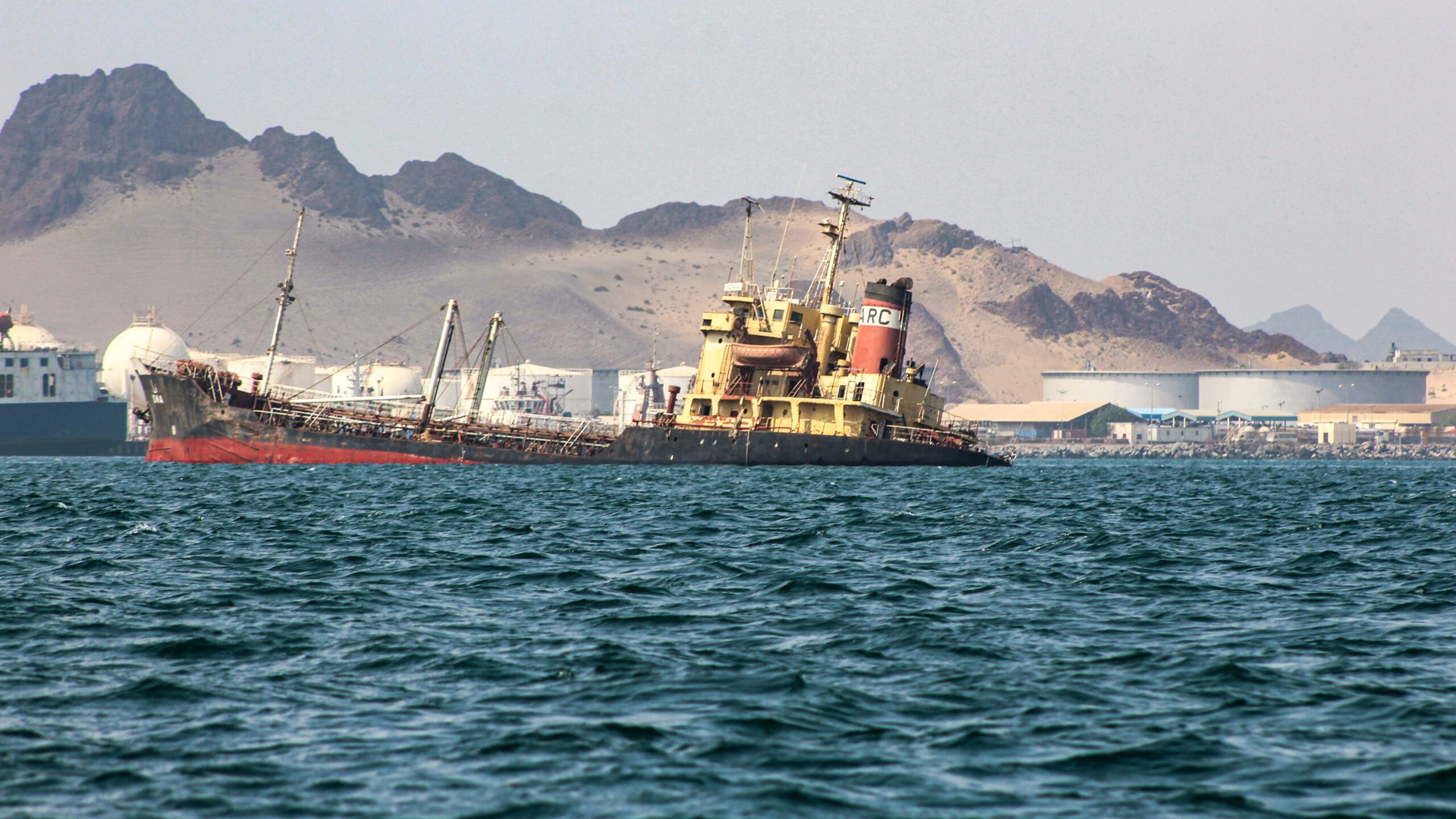Decaying oil tankers at the coasts of Yemen pose serious risks to the environment and the people depending on it, reminding us starkly how conflicts can bring serious pollution risks. New open source research by PAX reveals multiple oil spills from rusty ships that have been polluting the coastal areas around the Port of Aden. If no action is taken by the authorities to remove these ships, it is only a matter of time before a new disaster will unfold.
The ongoing war in Yemen continues to result in serious environmental challenges, as ongoing issues around its oil infrastructure and environmental governance continue to arise in the south of the country. Current international attention is mainly focused on finding a solution for the decaying oil tanker FSO SAFER loaded with 1.1 million barrels of oil. The tanker is at risk of sinking or exploding, which would create a regional environmental catastrophe. Yet over the course of the last years, smaller incidents around oil tankers in Yemen’s ports, the Red Sea and the Gulf of Aden have been mounting as well. Ranging from direct attacks on oil tankers to abandoned ships sinking and fires at port refineries, the conflict continues to create serious local pollution problems. The reality of these pollution perils became clear in early July, when PAX detected a large oil spill coming from one of the abandoned oil tankers in the Port of Aden, which continued for weeks. Yemeni journalists started asking questions and posted photos and videos of the oil slicks, calling for accountability of the owners to deal with these problems, and for the relevant government agencies to clean-up the oil spills. This new open-source investigation by PAX is a stark reminder of how conflicts can bring serious pollution risks, impacting eco-systems, livelihoods and potentially humanitarian aid.
The conflict’s impact on environment and livelihoods
The war itself already poses serious environmental challenges that impact both Yemen’s population and its precious ecosystems. This ranges from structural leaking oil incidents documented by the Yemen environmentalist group Holmakhdar and the Sanaa Center, to broader environmental problems, and conflict-linked cutting and dying of millions of date palms, demonstrated by the open-source investigative group Bellingcat. The current weak state of governance and oversight around the many environmental challenges Yemen is facing continues to result in ongoing incidents that worsen the state of environment and affect the people depending on it. Not only does this currently already lead to mounting environmental health risks and degraded ecosystems, these impacts will also worsen climate resilience for the conflict-affected country due to more extreme weather events, water shortages and rising temperatures. Proper environmental data collection and analysis is key for environmental peacebuilding and (post-conflict) reconstruction and rehabilitation efforts in Yemen.
Our findings below show that there are many smaller decaying tankers at risk of sinking. This is already posing serious problems for Yemen’s coastal fishing communities. Also, mounting risks of incidents with rusting oil tankers could seriously jeopardize the import of much needed humanitarian goods and hamper reconstruction efforts.
Fleet of Sinking Ghost Tankers
The Port of Aden is littered with decommissioned vessels, including those mooring in the bay and others, which have already sunk and rest on the bottom. Fuel tankers (off)load their cargo at the Oil Harbour, located at the west side of the Port, near the Aden Refinery company. Prior to the conflict, over 12 million metric tons of crude and refined oil products were handled annually through the five berths at the oil harbour, according to the Yemen Gulf of Aden Ports Corporation. A large portion of the oil transport in Yemen is conducted by the Alessi Group, run by the wealthy businessman Ahmad Saleh Al Essi. He makes millions importing oil and other goods, and his name is linked to a range of incidents discussed below.
The local authorities in Aden have struggled to regulate and monitor the oil industry in the port due to capacity issues related to the war. The Port of Aden is a pivotal area as it is the largest gateway to import food, humanitarian aid and reconstruction materials for the war-torn country. The city also hosts the Aden Oil Refinery, where concerns over leakages and spills around the oil industry has been a historical problem, as noted in a 2003 governmental assessment around pollution from mooring ships and oil infrastructure. The report outlined numerous incidents and the oil refinery was also flagged in 2006 as the biggest producing source of hazardous waste.
The July Spill Disaster
The latest large scale environmental incident started to develop on July 2, 2022. Satellite images from the commercial provider Planet show a small leak, possibly bilge water. The spill can be seen coming from the hull of a tanker north in the bay, which fits the measurements of an oil tanker. We have identified it as the SICHEM FENOL, which is roughly 107 metres long. The slick from the stern of the ship was also visible in days following July 2, but seemed to disappear after that. According the local port authorities, this ship still contains between 30 and 35 tons of heavy fuel oil, and any incident is expected to affect the local marine environment.
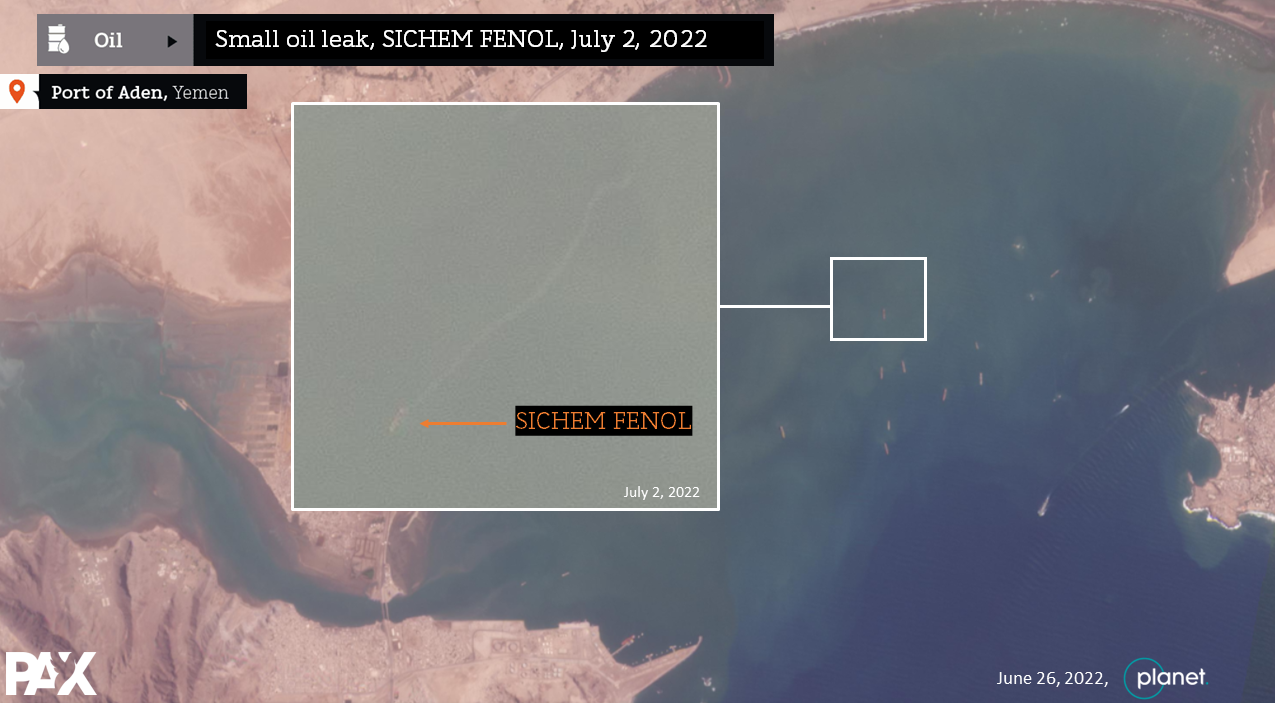
Then, a second huge spill occurred on July 5, coming from another ship, with a 14 kilometre long oil slick forming in and around the port of Aden, as seen on Planet imagery. The spill stretched all the way south outside the port to the northern and western coastal areas inside the harbour. The images show a mix of heavy oil and a light oil sheen on the surface of water, amidst over a dozen other ships mooring in the Port of Aden. The spill ranged from the west around the offloading station near the refinery to the beaches on the southwest, as well as part of the spill floating to the northwest following the current.
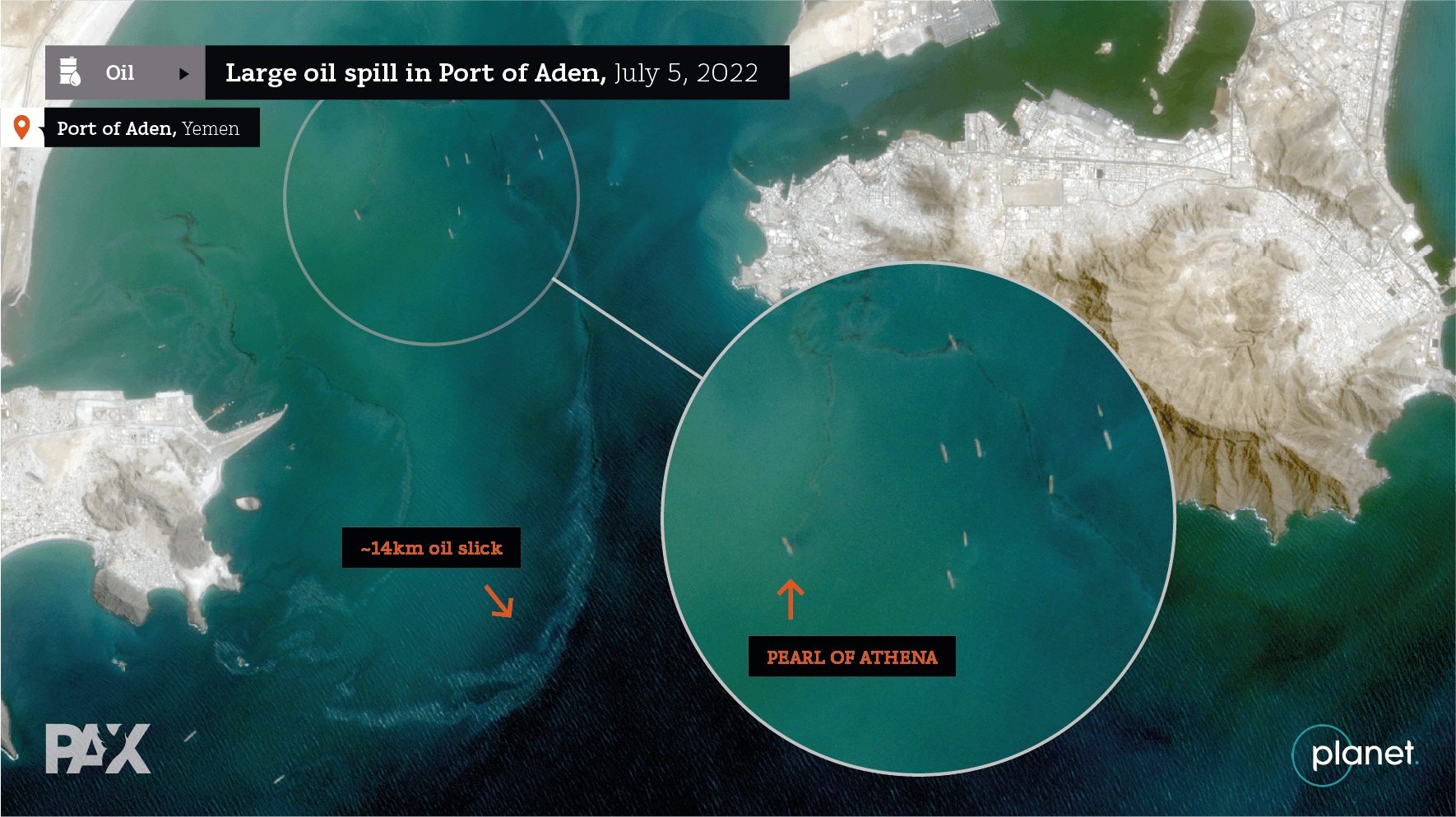
Optical satellite imagery from the European Space Agency’s Sentinel-2 from the next day, July 6, show how the spill concentrated in the middle of the bay in the Port of Aden, forming a huge oil slick of at least 2.5 km2, visualized in the image below (colour adjusted from the original colour for clarity), with a sliver of oil seen coming from an oil tanker that later was identified as the PEARL OF ATHENA, being the source of the spill.
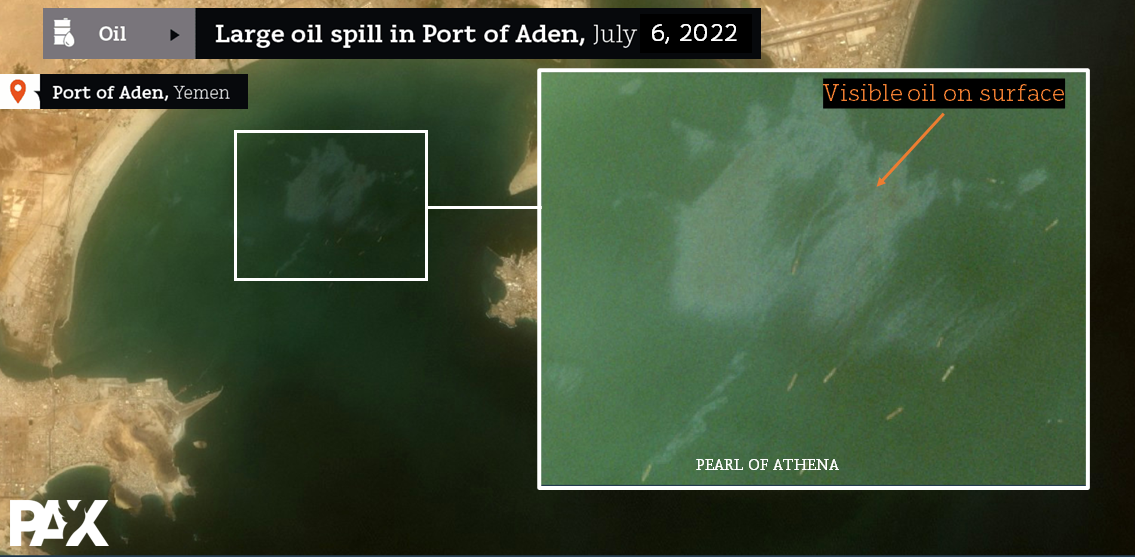
Through the weeks that followed, the oil slicks continued to spread in the port from the leaking tanker for weeks, with the largest spill seen on a satellite image dated July 23, 2022, which still showed an oil sheen spreading around the bay in the Port of Aden. After that date, no oil is visible around the PEARL OF ATHENA.
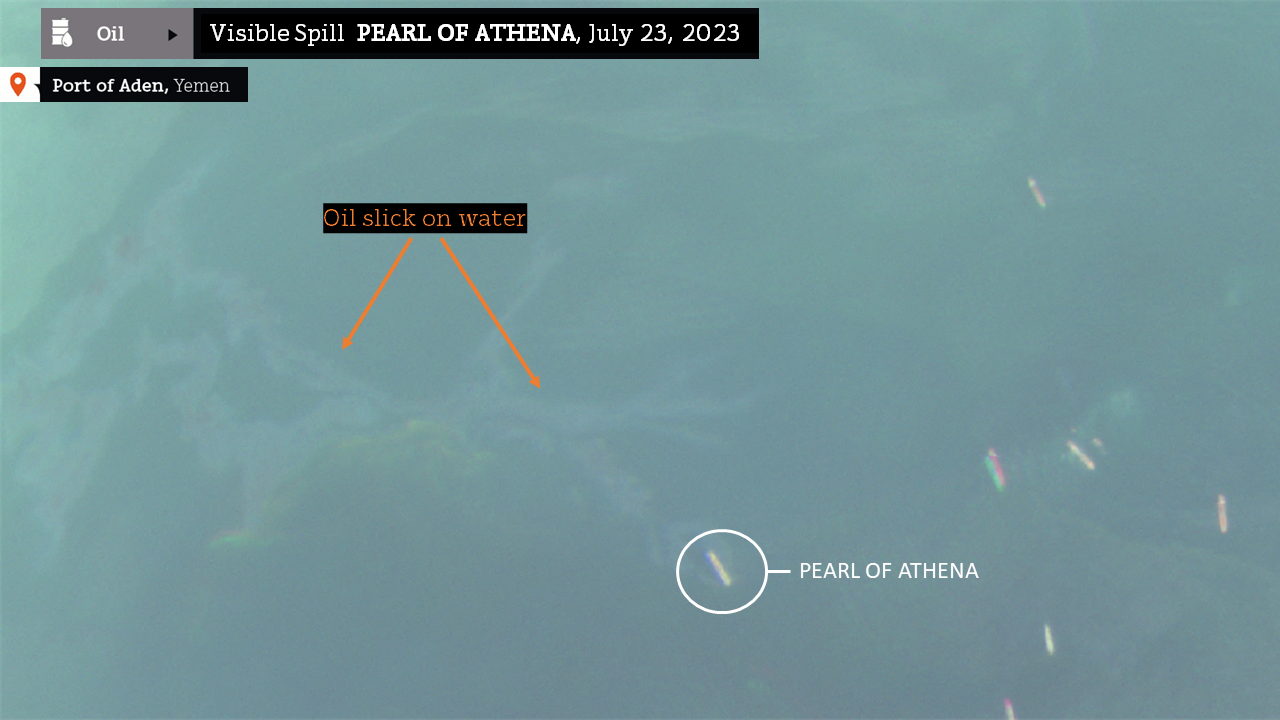
The spill remained largely unnoticed by the media until PAX started to publish the satellite images of the spill, which were then rapidly picked up by local journalists and experts. A first image appeared on Twitter, showing the source of the spill. This was later confirmed to be the PEARL OF ATEHNA in the satellite imagery through geo-location.
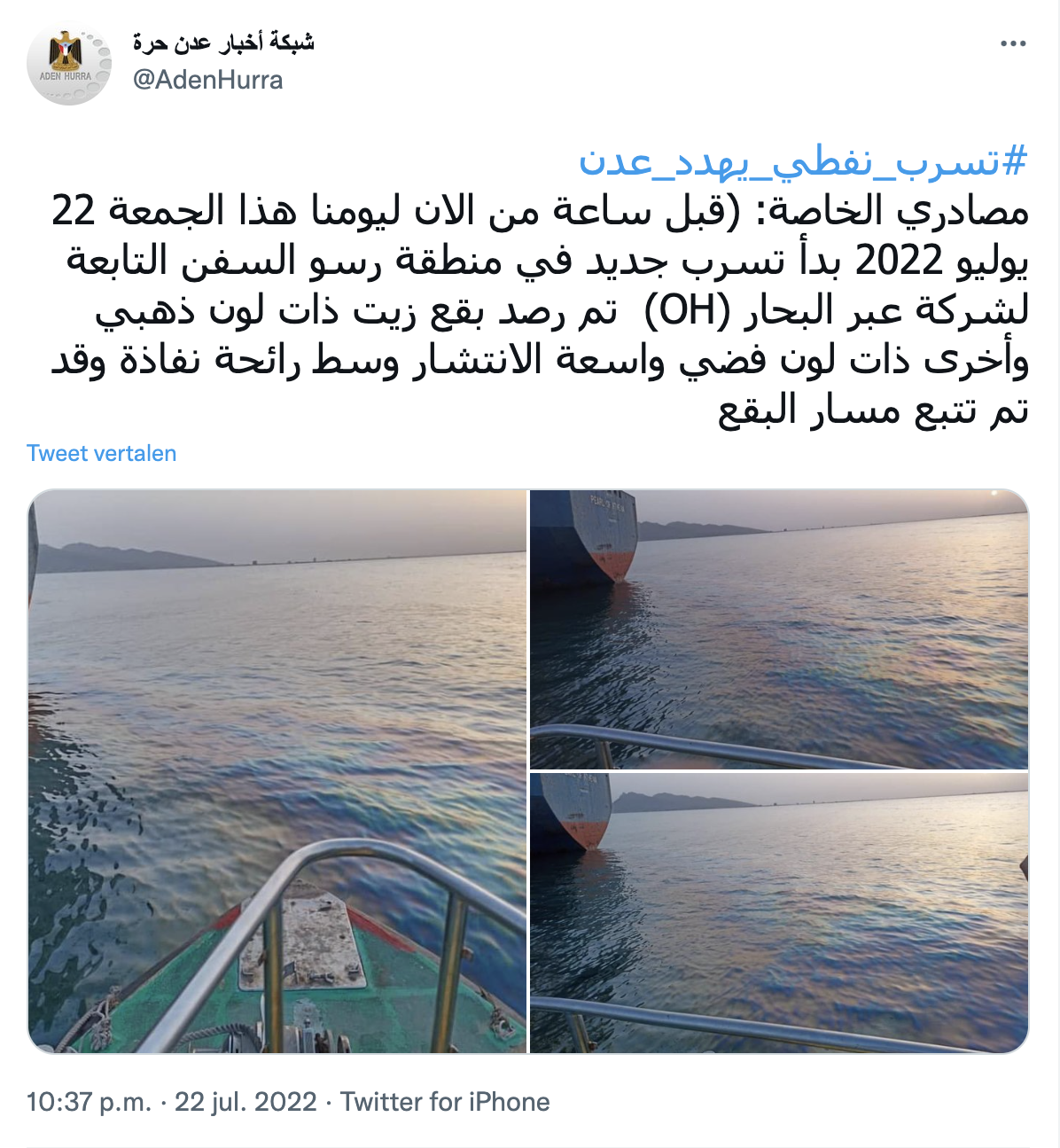
According to Vesseltracker, an open-source marine tracking website, this 20-year old tanker sailing under the flag of Malta is 121 metres long, 28 metres wide, and has a gross dead weight tonnage of 8750 tons. Other similar websites also provided the previous names before it switched owner, when it was known as PEARL of SALALAH, MICHAELIS and HULDA MAERSK.
At the time of the incident, the kind of fuel onboard (e.g. diesel, refined oil, crude or heavy fuel oil) was unknown. The ship is owned by the Cooperative Credit Bank in Sanaa and is managed through the Oversees Shipping and Stevedoring company, based in Hodeida. According to the statistics of the Regional Maritime Center for Information Exchange, the ship first moored in the Port of Aden on August 23, 2015. However, the ship was mooring at a different location inside the Port and seemed to have been moved after April 28, 2022 to its current location. We compared images with Sentinel-2 and observed that the PEARL OF ATHENA was moved between April 27 and April 30, 2022. We used an image from April 14 in the comparison below for clarity due to some cloud cover on April 27. Another option is to compare the images via this Planet slide link. This raises the question of whether the movement of the ship could have triggered the later breakdown of the ship and the resulting oil spill.
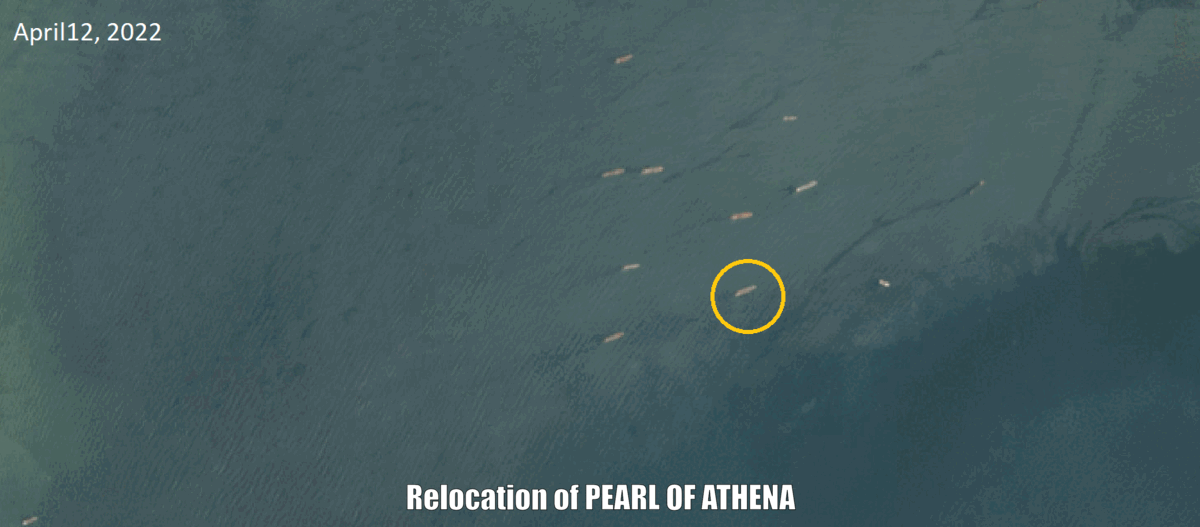
The satellite images lead to questions from local journalists and soon a public statement was released by the Port authorities on the spill with a map accompanying the situation at the Port showing the spread of the spill and the current location of the PEARL OF ATHENA. According to the experts, over 40 tons of oil was leaked from the leaking tanker, though this has not been confirmed by the local authorities.
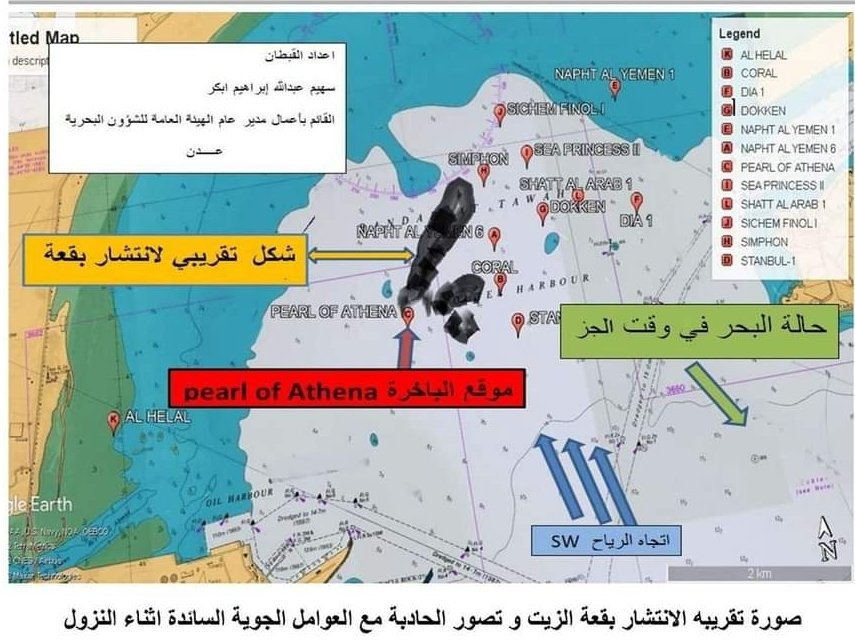
The map is helpful as it identifies other decommissioned oil and chemical tankers deemed to be at risk from sinking and which could pose additional environmental pollution impacts. A similar overview can be found in Vessel Traffic Control report on the website of the Port of Aden that includes the full list of ships anchoring or visiting per July 25, 2022.
Using the information from the map, an overview can be created on the types and sizes of the tankers located there:
|
Name |
Type |
Storage |
Length/width |
Callsign |
Owner |
|
NAPHT AL YEMEN 1 |
Tanker |
8205tons |
117m/15m |
9LB2350 |
|
|
NAPHT AL YEMEN 6 |
Tanker |
5297 tons |
130m/19m |
9LB2349 |
|
|
CORAL |
Tanker |
4999 tons |
95/15.5m |
9LE2095 |
|
|
SICHEM FENOL |
Oil/Chemical Tanker |
7158 tons |
107m/18m |
9LU2112 |
Shipping Agency Services |
|
DOKKEN |
Oil/chemical Tanker |
12964 tons |
127m/23m |
9LE2019 |
|
|
SHATT AL ARAB 1 |
Oil Tanker |
9917 tons |
129m/21m |
A6PW |
|
|
SIMPHONY |
Tanker |
10885 tons |
123m/18m |
9LU2103 |
|
|
DIA-1 |
Oil tanker |
4999 tons |
104m/15m |
ERKS |
sunk |
|
AL HELAL |
LPG tanker |
910m3/762 tons |
62m/10m |
/ |
|
|
SEA PRINCESS-1 |
Oil tanker |
3399 tons |
81m/13m |
9LU2114 |
|
|
ISTANBUL-1 |
Oil tanker |
12824 |
123m/20m |
9LU2118 |
Shipping Agency Services |
Sources: Marinetraffic, Vesseltracker, Balticshipping
As noted, in the days following the publication of the satellite images of the spill on social media, Yemeni activists and journalist started raising awareness on the issue, posting pictures and videos of the oil washing on the shores of Aden, and urging people to use the hashtag تسرب_نفطي_يهدد_عدن# (Translation: Oil leaks threatens Aden)
In follow-up reporting by local media organisations that spoke with Port authorities, experts and fishermen, all expressed concern over how these spills affected the livelihoods of fishing communities, local marine biodiversity and vulnerable habitats for protected and migratory birds. On July 31t, 2022 , a new investigation by the Yemeni journalist Basam Al Qadi revealed that remaining mooring dilapidated tanker, the CORAL, with a carrying capacity of roughly 5,000 tons, still has 90 tons of oil on board. Could this be the next environmental catastrophe in the Port of Aden?
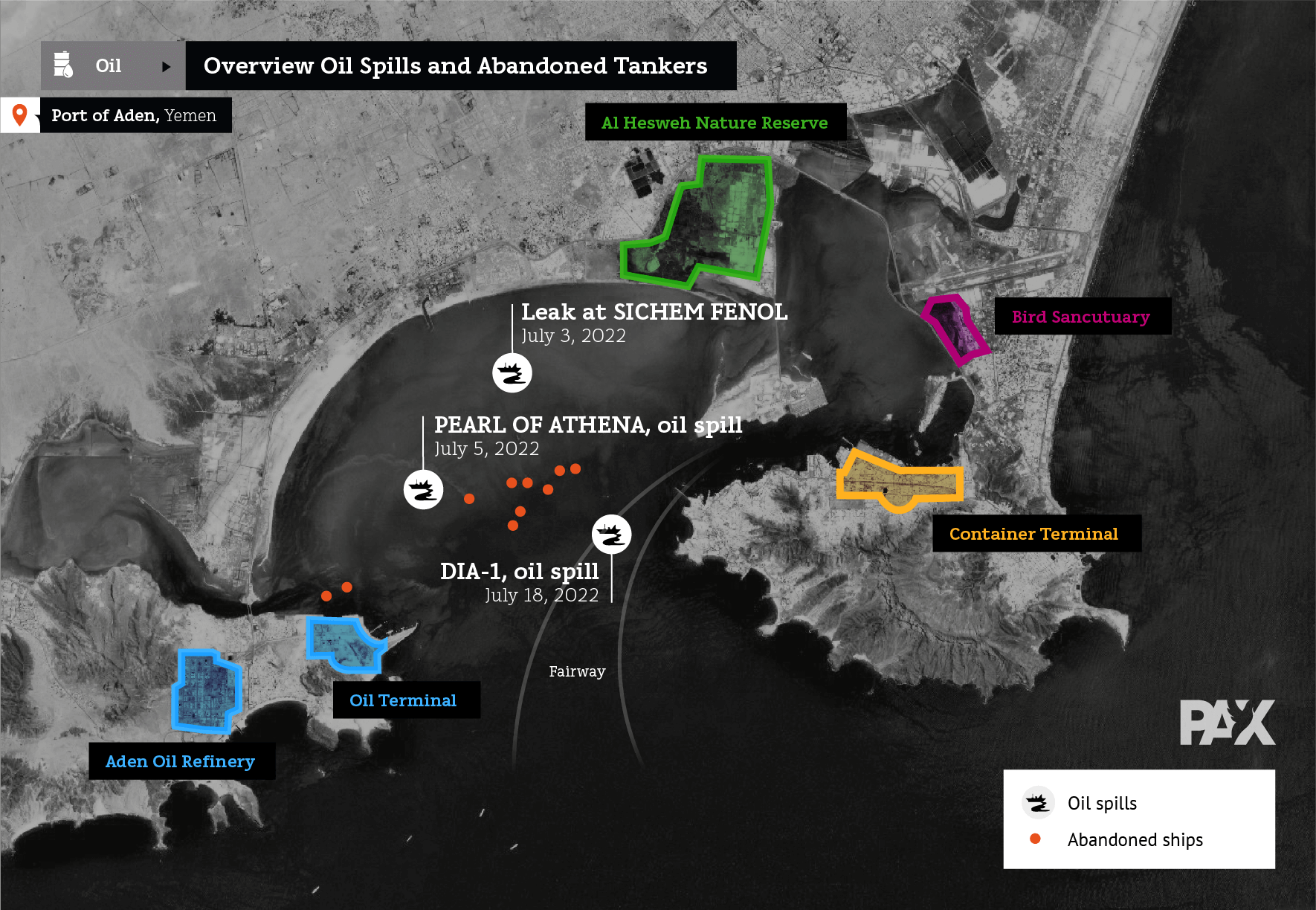
In sum, PAX has observed leaks from two ships, including a large spill on July 5,2022 from the PEARL OF ATHENA that continued for 18 days until July 23. Oil slicks have washed ashore, polluting the coastal environment, and could pose a long-term risk to the marine environment in and around the bay of Aden, which could pose particular threats to the livelihoods of fishing communities. Hydrocarbons from crude oil and refined products contain toxic heavy metals such as lead, zinc, cadmium and mercury that can accumulate around coastal soils and sediments, be ingested by marine organisms such as fish, affect marine birds and mammals and impact marine ecosystems.
Large spills such as this one are also likely to hold up the arrival of ships that need to offload humanitarian goods in the container terminal. This is because ships are not able to go into the port until such slicks are removed to prevent further dispersal of the oil by the movement of incoming ships.
Failing Environmental Governance
The massive oil spill from the PEARL OF ATHENA comes almost exactly one year after another tanker, the DIA-1, sank in the Port of Aden also causing a widespread oil spill. On July 18, 2021, this diesel tanker, which had been mooring in the port since 2014, began to take on more water and started to sink. This caused a 20km long spill stretching far south of Aden’s beaches and threatening the already conflict-affected Al Heswah nature reserve. Here too, PAX identified the spill and used satellite imagery to monitor the scale and spread of the oil slick. Like the PEARL OF ATHENA, the DIA-1 also belongs to the shipping company owned by Ahmed Saleh Al Essi. The sunken vessel has still not been removed, and occasionally, small leaks can still be seen coming from the DIA-1.
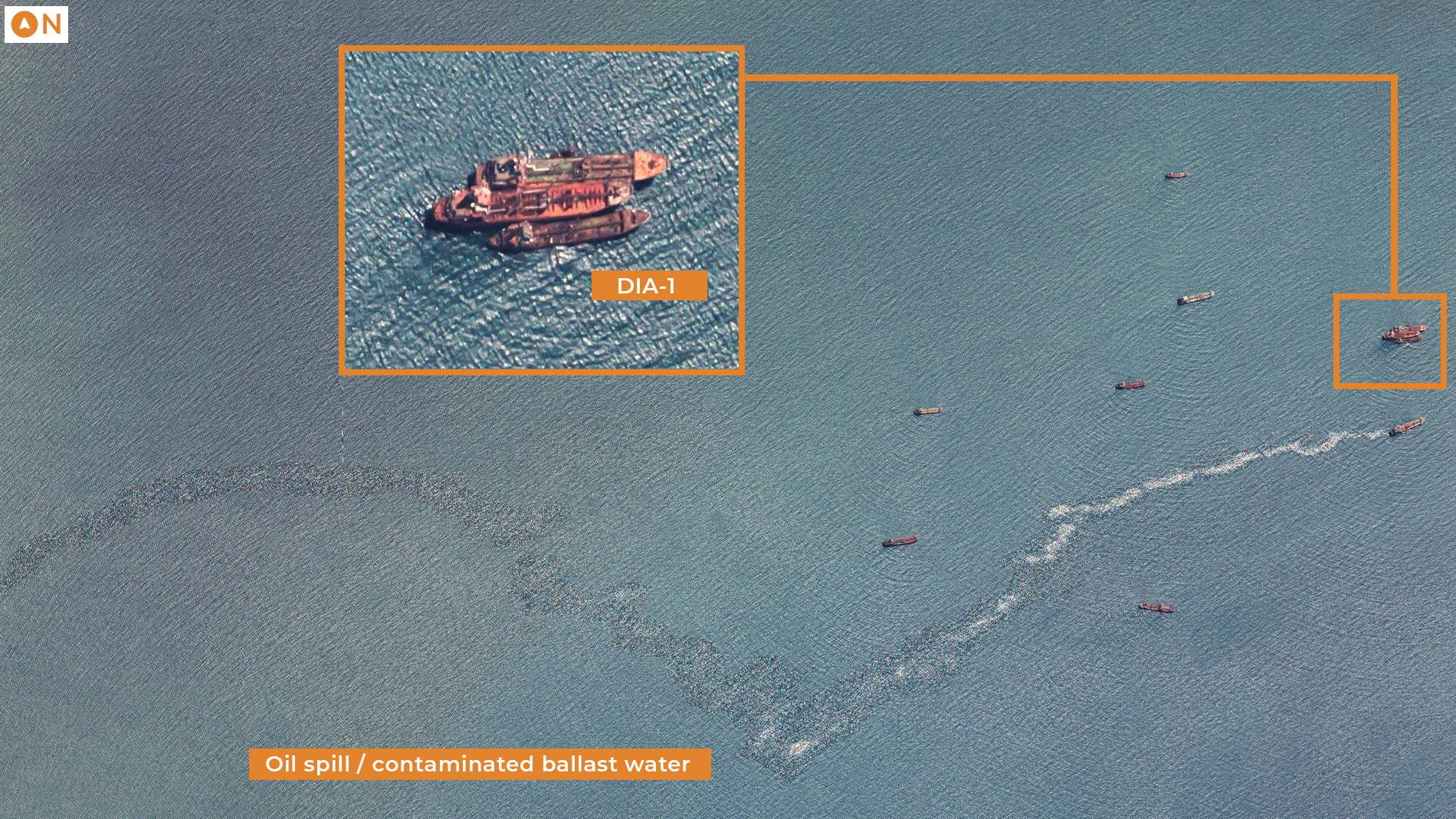
A similar incident occurred in September 2019, when the abandoned oil tanker Rudeef GNA sank north of oil loading terminal, causing a small oil spill. This oil tanker was previously attacked by pirates off the coast of Yemen in 2011, according to unclassified reports.
The ongoing war in Yemen continues to stress local authorities’ capacities to address both the issues with dilapidated oil tankers and set up a proper environmental monitoring and enforcement mechanism for ships arriving in the Port of Aden. This results in continued spill incidents from ships dumping contaminated bilge water, the sinking of ships and resulting oil spills, and other dangerous incidents in the Oil Harbour. A damage assessment conducted by the UN Development Programme (UNDP) in 2021 found that at over 20 million USD was needed for reparations at the container terminal alone. The report, also stated that:
“Health, safety, and environmental awareness in the Port is currently unacceptable. The Port contains large areas of conflict-damaged debris, damaged and unusable equipment, and equipment and materials being stored for future use.”
The poor conditions at the Aden Oil Refinery on the Al Burayqah peninsula at Aden’s Oil Port have already resulted in protests from workers, in which they demanded payment and complained about lack of medical care for sick employees. The deteriorated conditions have also made the location prone to accidents, including on June 9, 2022, when a large fire broke out at the oil refinery loading station for fuel tankers, leaving several people wounded. The fire may be an indication of how accident-prone the location is. Earlier, on May 19, 2020, a similar incident occurred when a fuel pipeline caught fire at the refinery, and spills from visiting tankers can also frequently be seen in publicly available satellite imagery. Below is a compilation from Planet:
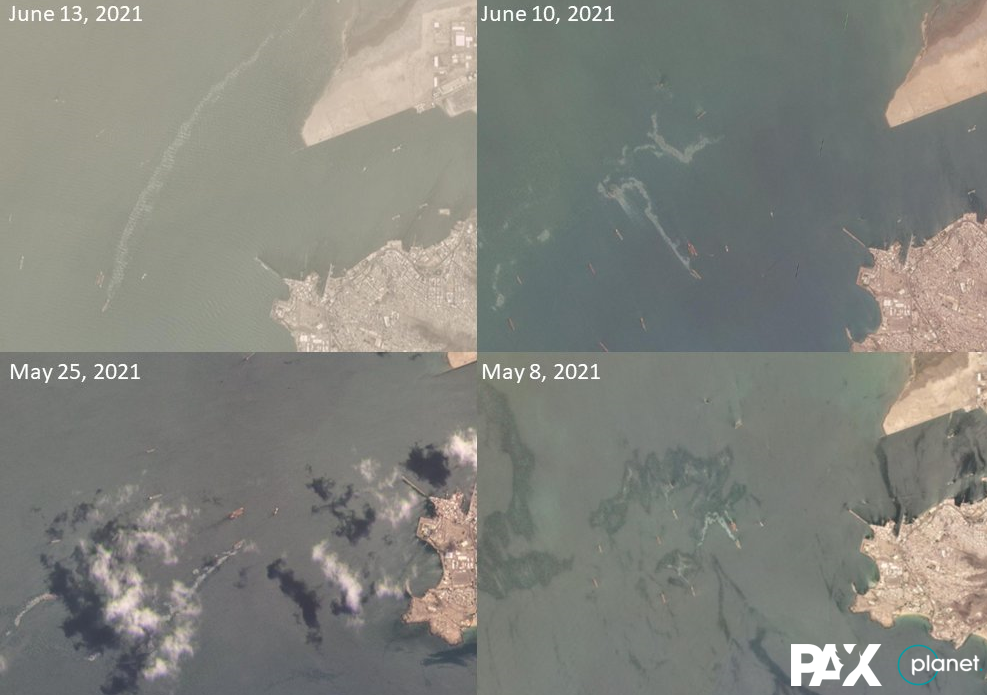
Oil shipping in and around Yemen has also faced threats from armed actors. In early January 2019, a large explosion rocked the refinery in Aden, allegedly from a Houthi drone attack, causing significant damage. The Houthis also shelled the refinery in 2015, causing a large fire at one of the fuel storage tankers.
As was noted in a 2015 assessment on the State of the Marine Environment in the Red Sea and Gulf of Aden also underscored the many risk that visiting and mooring ships are posting to the marine environment and coastal eco-system:
“The arrival of ballast water on ships trading to ports in the Red Sea and Gulf of Aden (..) has the potential to do more harm to the marine environment than a major oil pollution incident. (..) Dumping of hazardous materials at sea in waters close to the Gulf of Aden has the potential to carry serious pollution hazards into the region.”
The need for prevention and restoration
To ensure that environmental damage caused by decaying tankers in the Port of Aden are prevented, a large-scale operation to remove all these oil tankers is of urgent priority. The ongoing war continues to pose serious humanitarian and environmental risks to a population struggling daily with the destruction brought upon the country. These wider secondary impacts of the conflict need to be addressed with urgency, particularly the failing environmental governance to address issues around the oil industry and shipping. Thus far, the international community has failed to pick up the bill to effectively prevent a major environmental disaster with the FSO SAFER, despite the UN starting a public campaign to raise $20 million dollar to prevent a serious disaster posed by the tanker. Meanwhile, western countries continue to allow for billions in weapons sales to the countries bombing Yemen.
The remaining tankers in the Port of Aden continue to pose a risk of sinking, which would likely lead to further environmental pollution with effects on coastal areas. This would particularly impact fishing communities and surrounding ecosystems. Heavy metal from oil spills are likely to accumulate in fish and sediments, a problem already established around the west-coast of Yemen and the Red Sea. Research shows that Yemen’s fishing industry already suffers immensely from the war, potentially worsening food insecurity and unemployment. The UN recently started to provide grants to fishing communities around Aden and Mukalla to support their businesses. At the same time, the risks of these spills could hinder the import of humanitarian supplies in case of an accident.
A current assessment made by a non-profit organization focusing on Yemen’s capacity to respond to oil spill incidents paints a bleak picture, describing the absence of a government strategy and limited means. As witnessed and documented in other conflict-affected areas, state capacity is often seriously undermined due to armed conflict, leading to destruction of equipment, looting, loss of expertise and damage to facilities. Often, this results in worsened environmental problems due to lack of proper oversight and enforcement of the regulatory environmental framework.
Based on these incidents and wider structural problems with environmental governance, the following recommendations are made to the international community in support of Yemeni authorities and civil society organizations:
Coordinated and comprehensive clean-up:
- The owners of these ships and port, in this case the Alessi group, need to take responsibility and fund the safe removal and clean-up operations around the Port, in line with Yemen’s national Environment Protection Law.
- The international community must work with local authorities and communities to develop and implement a comprehensive strategy to remove all decaying ships in the Port of Aden, clean-up existing coastal and marine pollution and set up monitoring systems to prevent any future incidents from mooring vessels.
Supporting implementation of international marine conventions:
- The international community must provide funding and expertise for relevant authorities to boost capacity on development, updating and enforcement of existing national environmental regulations, and ensure ongoing work is and in line with the international agreements of which Yemen is a member. For example, the International Convention on the Prevention of Marine Pollution (ICPMP); the International Convention for the Control and Management of Ships’ Ballast Water and Sediments, that entered into force in 2017, and the Regional Convention of the Conservation of the Red Sea and Gulf of Aden Environment (RCCRSGAE) . The latter convention recognized that the “pollution of the marine environment in the waters of the Red Sea and Gulf of Aden by oil and other harmful or noxious materials (…) especially through indiscriminate and uncontrolled discharge of these substances, presents a growing threat to marine life, fisheries, human health, recreational uses of beaches and other amenities.” Those States signed up to the Convention (amongst others: Jordan, Saudi Arabia and Yemen) committed themselves to combat pollution in the Sea Area caused by intentional or accidental discharges from ships.
Strengthening environmental governance, accountability and advocacy:
- Additional funding by other actors is needed for monitoring and enforcement of environmental regulations to track ships dumping contaminated wastewater in and around the Port of Aden.
- The international community must engage with local communities, civil society organizations and experts to ensure relevant concerns from marine pollution incidents are being collected and addressed. This could foster confidence-building in local authorities, strengthen accountability, and ensure timely notification of incidents that have not yet been detected.
- Yemen should highlight concerns over conflict-linked environmental degradation and call for a coordinated international response and support in relevant international forums, including the UN Environment Assembly, General Assembly, Human Rights Council, and Security Council. This should also include support for a UN-system-wide approach to improve the UN’s capacity to respond to incidents in the future.
We would like to thank our Yemeni friends and colleagues, Basam Al Qadhi of the Humanitarian Journalism Foundation and Holm Akhdar, for their collaboration and valuable suggestions and comments.
Illustrations made by Frans van der Vleuten.

